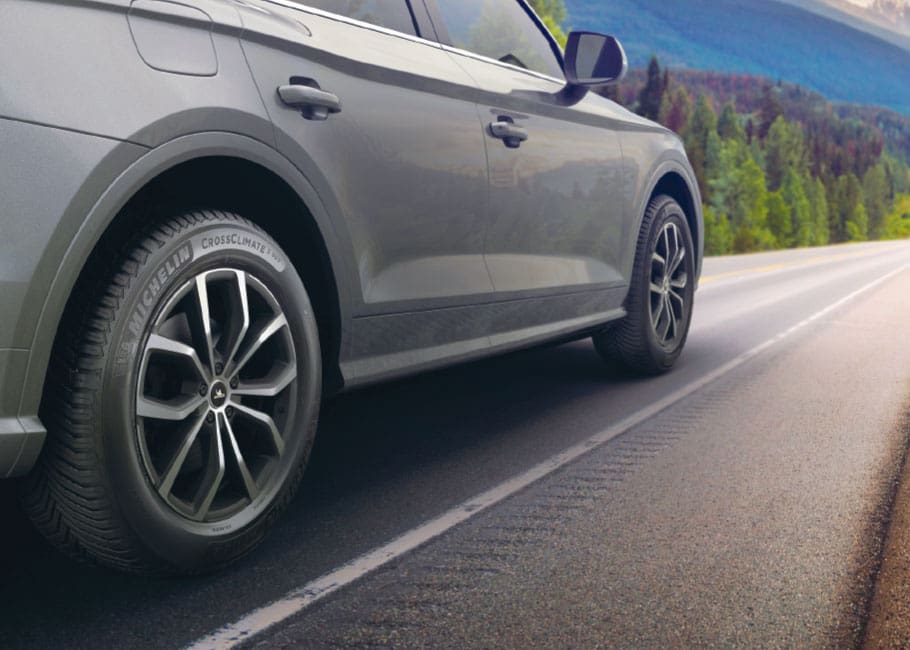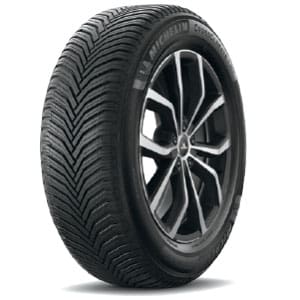AUTOMOTIVE

PHOTOS: © 2023 MICHELIN NORTH AMERICA, INC. ALL RIGHTS RESERVED
A tire for every season?
An explanation of the pros and cons of all-season tires
by TOM BEAMAN
All-terrain, all-weather, mud, performance, winter/snow, summer: A dizzying number of tires are available with all kinds of features and claims. Even if you are pretty sure you know what kind of tires you want, it’s wise to consider what, when and where you’ll be driving.
According to the Tire and Rubber Association of Canada (TRAC), if you drive a high-performance sports car in temperatures between 7 C and 40 C (45 F and 104 F), summer tires are best. They provide better grip and optimum handling, braking and cornering in this temperature range whether roads are wet or dry. On the other end of the spectrum, TRAC says, temperatures below 4 C (39 F) and heavy snow call for a dedicated winter tire with aggressive tread patterns and a softer rubber compound that can stop a vehicle in half the distance of a summer tire. And then there’s a middle ground—all-season tires—that many people find works well for them.
The tire that does it all, kind of
For everyday driving, all-season tires offer longevity and good performance in rain and light snow and at temperatures above 7 C (45 F). Introduced in 1977 by the Goodyear Tire & Rubber Company, all-season tires offer many motorists an alternative to the dreaded biannual task of swapping regular tires for winter variants. “[All-season tires] afford consumers the possibility of not having to buy two sets of tires and wheels in most weather conditions,” says Tracey Norberg, senior vice president and general counsel of the U.S. Tire Manufacturers Association. Most new vehicles are fitted with factory-installed all-season tires because they are designed to perform well under most conditions, most of the time.
“The great thing about all-season tires is that for most people they are a one-stop shop,” says Barry Yutronkie, TRAC’s director of operations. “They are designed to be a more general, all-around product covering a wide range of temperatures and conditions, up to and including light snow.” Like winter tires, all-season tire rubber compounds are engineered to stay flexible in temperatures as low as 7 C (45 F) so they don’t skid across slick surfaces like a frozen hockey puck. Longevity is another benefit of all-season tires. Some have limited warranties as high as 130,000 kilometres, compared to summer tires whose warranties often start at around 30,000 kilometres and dedicated winter tires that offer upward of a 60,000-kilometre warranty.
Types of all-season tires
All-season tires typically carry the mud and snow (M+S) symbol on the sidewall that indicates the tire meets industry standards for traction capabilities in mud and snow under temperate conditions. All-season tires with the Three Peak Mountain Snowflake (3PMS) symbol—a six-pointed snowflake inside a mountain moulded into the sidewall—fall between all-seasons with the M+S rating and pure winter tires.
“3PMS all-season tires perform better than a regular all-season tire but not as well as a true dedicated winter tire,” says Yutronkie. “They are a compromise between an all-season and a dedicated winter tire, and you can run them in the summer. If you are not doing a lot of winter travelling but you want that little extra safety edge, that might be the option for you.”
In British Columbia, winter tires with 3PMS or M+S ratings are required on vehicles from October 1 through April 30. In Quebec, 3PMS winter tires are mandatory from December 1 to March 15. Choosing the right tires for your specific needs is one of the most important things you can do to stay safe on the road. The experts in Costco Tire Centres can tell you if all-season tires are your best option for how and where you drive.
Going electric
As more people opt for electric vehicles (EVs), tire manufacturers are re-engineering their products to meet the specific demands of EVs. Due to their large batteries, EVs are often heavier than internal combustion engine (ICE) vehicles and have more tire-chirping torque, so their tires, on average, wear out 20% faster than tires on a comparable ICE vehicle. As long as load capacity restrictions are observed, Michelin tires sold by Costco will function properly on both ICE vehicles and EVs. The stiffer rubber compounds and robust structure can help to offset the 20% greater wear impact of EVs and increased load capacity. An EV’s range can be increased with low-rolling-resistance tires.—TB

Make them last
The U.S. Tire Manufacturers Association offers these tire care tips:
- Maintain correct tire pressure to maximize vehicle performance and fuel economy. Check the pressure once a month on cold tires.
- Inspect tires regularly for uneven wear, smooth spots and tread depth of 0.15 centimetre (1/16 inch) or less.
- Rotate tires every 12,875 kilometres and have them aligned if the vehicle pulls to one side—TB
Tom Beaman is a freelance writer based in Rochester Hills, Michigan.
Costco Connection: Between its warehouses and Costco.ca, Costco offers some 5,000 styles and sizes of tires to fit your car, truck, SUV, trailer, industrial-grade all-terrain vehicle—and even your golf cart. To learn more, visit your local Costco Tire Centre and talk to trained staff members, or check out the selection on Costco.ca.

